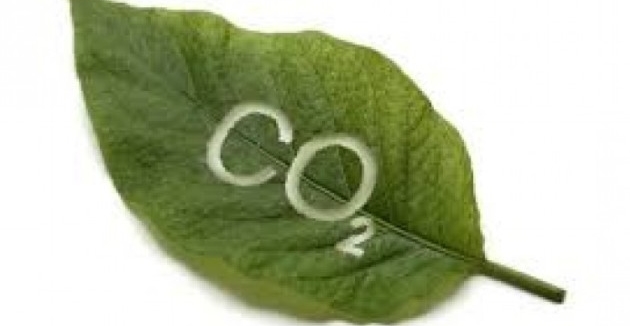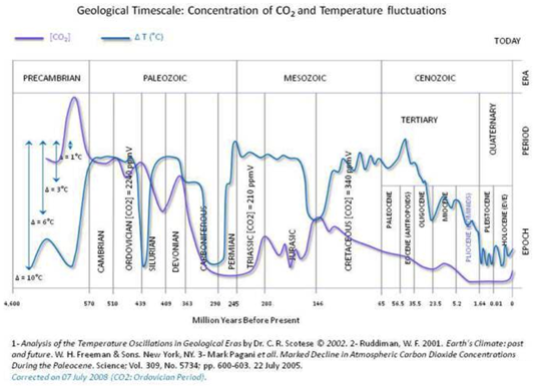WARNING: Dangerous Carbon Dioxide Shortage!
WARNING: The following column may awaken feelings of apprehension, fear, and panic if you believe there is a climate crisis approaching due to carbon dioxide in the atmosphere.
You’ve certainly heard from ABC, CBS and NBC that there is a developing crisis that is the most serious that the world has ever faced. Our Secretary of State, the Honorable John F. Kerry, likens it to the most terrible weapon of mass destruction. President Obama has vowed to make it the highest priority of the remaining two and one-half years of his administration. (Not the limping economy, not the Mullahs’ quest for The Bomb, not the Putinization of Europe.)
This crisis is due to the amount of carbon dioxide (CO2) in the atmosphere, presently 400 parts per million by volume (400 ppmv), or 0.04% of the atmosphere. This is dangerously low, far less than it has been for most of Earth’s existence, and both human policy and natural climate processes threaten to reduce it below an essential minimum. Nothing bad – certainly nothing catastrophic – happened in the golden eras while CO2 was at several thousand ppmv.
The same crackpots insist that the Earth is becoming much too warm. This is also untrue. The Earth is presently much colder than it has been for most of its history, and is likely to become even colder – eventually much colder. Like previous eras of abundant CO2, nothing bad happened when Earth was warmer. But, in cold eras, glaciers destroy whole countries, agriculture suffers, humans and wildlife die in cold and snow, and large parts of Earth become uninhabitable. A cold climate, such as we have now, makes life much harder for all.
As you see in the below diagram, CO2 content has usually been much higher than now, usually over 2000 ppmv, five times the current value. Food plants– the source of all food on this Earth – evolved in an environment of much higher CO2, and have had to deal with an ever more hostile environment, as CO2 has declined. As any nursery or garden store will tell you, they maintain a plant-friendly environment of 1,000 ppmv. Ever wonder why YOUR flowers don’t look as strong and beautiful as they did in the store? You’re starving them; they’re not getting enough of the food they need – CO2. Go breathe on them for five minutes a day; your exhalation is about 40,000 ppmv of CO2. That’s one hundred times as much CO2 as they get from the air in your home. They’ll love it. [Hat tip to Joe Bastardi for the diagram.]
In fact, plants are so unhappy in our present (last 25 million years) low-CO2 environment that a new, low-CO2 vegetation type has evolved, the C4 crops, such as maize and millet, which can conduct photosynthesis with less atmospheric CO2. Older forms of vegetation, the C3 crops, such as wheat, rice, barley, evolved when atmospheric CO2 was higher. Plants gather CO2 through stomata, openings in their leaves; however, they also lose water vapor (H2O) through those stomata, especially in a dry climate, so it’s a tradeoff. Getting food production underway with less need for carbon and less water loss is a great evolutionary advantage. Darwin’s Theory of Evolution by Natural Selection works for vegetation too. It’s also good for humans, since every carbon atom in every human body came from a molecule of CO2 in the atmosphere. And, of course, every cell in your body is replaced every seven years. Do you really want to minimize atmospheric CO2?
Before Watt’s invention of the coal-burning steam engine, CO2 content is estimated to have been about 280 ppmv, or 0.028% of the atmosphere. The necessary minimum to sustain global photosynthesis is thought to be 200 ppmv. We weren’t far from a massive die-off of vegetation, and we may approach this dangerous level again. So far, we have reversed the disastrous decline of atmospheric CO2 by burning coal, the fuel richest in plant nutrient. Multispectral NOAA satellite data reveals the increase of vegetation since the 1970’s, due to our coal-based greening of the world. CO2 is good for humans and for the natural world.
One of the things Mr. Gore demonstrated in An Inconvenient Truth is that there’s a correlation between temperature and atmospheric CO2 content. He “forgot” to mention that it’s a lagged correlation; first the temperature goes down, then – 800 years later – atmospheric CO2 content goes down. Cold oceans absorb CO2 out of the atmosphere, to the detriment of plant growth – the growth we depend on for food. As you can see on the graph, we’re now both cold and low on CO2.
This is the most important lesson to learn from Gore’s movie, though it’s certainly not what Gore meant to teach: cooling oceans take out of the atmosphere the CO2 that is essential for the growth of our food. Of course, cooling also shortens the growing season. There’s a double whammy in declining temperatures.
On the geologic time scale, Earth has been in a very cold era for about 25 million years, after continental drift positioned a continent over the South Pole and a blocking ring of continents around the North Pole. Both are impediments to the free circulation of equatorial oceanic currents across the poles. On top of that handicap, we are subject to long-term glacial conditions (90,000 years), interrupted by brief (11,500) interglacial periods, the Milankovitch Cycle. All of human history – art, science, music, philosophy, civilization itself – is contained within the current inter-glacial: the last 11,500 years. We’re nearing the end of the present relatively warm inter-glacial.
Other processes beside cooling remove CO2 from the atmosphere. Precipitation is one; you’ve probably noticed your lawn is greener after natural rain than it is after watering from a sprinkler. Raindrops pick up CO2 in falling through the air, becoming carbonic acid. That mild acid, over geologic time, wears mountains away and washes them into the sea. In the process, the CO2 becomes combined with calcium, forming calcium carbonate (limestone). This is one of the reasons the alarmists’ claim that “carbon dioxide is turning the oceans to acid” is untrue. The oceans have been basic (pH = 8.2) for millions of years and will remain so; the ocean bottoms are covered with huge amounts of limestone, which acts as a buffer against acidification.
Of course, when warm temperature and high CO2 content coincide, as in the Cretaceous Period, Earth experiences a profusion of vegetative growth. We’re enjoying the benefits of that past growth now, in the coal and natural gas that makes civilization and prosperity possible. Obama and Kerry are focused on reducing atmospheric CO2, under the leadership of the UN and a new, “better” Kyoto Treaty. They will try to commit the USA to this act of suicide in November, 2015, in Paris.
This self-inflicted wound would be bad enough, but Nature is already heading toward cooling temperatures – due to the declining solar cycle – and our descent toward the next Milankovitch Glacial era. This cooling will send more of the essential CO2 into the oceans, where it does humanity no good.
Climate Bonehead of the Week
This is always a hotly contested race. John Kerry is usually a contender, and Obama could rest on his laurels and still be near the front. But let’s be sporting about this; let’s recognize a new contestant, one who has earned distinction in a field even more beset with failure, i.e., “the dismal science.” Ladies and gentlemen, I give you Henry W. “Hank” Paulson, writing in the New York Times:
“We are building up excesses (debt in 2008, greenhouse gas emissions that are trapping heat now). Our government policies are flawed (incentivizing us to borrow too much to finance homes then, and encouraging the overuse of carbon-based fuels now). Our experts (financial experts then, climate scientists now) try to understand what they see and to model possible futures. And the outsize risks have the potential to be tremendously damaging (to a globalized economy then, and the global climate now).”
Does anybody believe Hank Paulson and government economists are “experts”?



